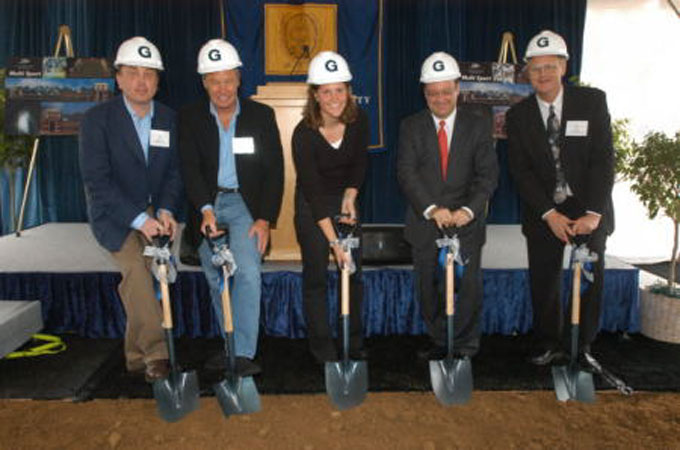
"A new era in Georgetown Athletics took another step forward as team captains, students, alumni, donors and University officials, as well as, members of the Georgetown community attended the groundbreaking for the Multi-Sport Facility on April 30th. Speakers included Interim Director of Athletics Adam Brick, Associate Head Women's Lacrosse Coach Bowen Holden, parent and member of the Board of Directors Peter Cooper, Vice President of Student Affairs Todd Olson and University President Jack DeGioia. All spoke of the importance of this project not only for the future of Georgetown athletic success, but also for the entire Georgetown community."
-GUHoyas.com, May 3, 2005
On a cold and rainy Saturday not that long ago, I found my way across a mud-filled Harbin Field to a tent filled with alumni, parents, and assorted development officials. Speeches were made, shovels were cast into the dirt, and celebratory t-shirts were handed out. It read:
MULTI-SPORT FACILITY GROUNDBREAKING: APRIL 30, 2005
What I most remember wasn't the speeches or the plaudits, but one single remark. I forget to this day who said it to me, albeit in passing, but I remember the message, endemic of what this project has become. "The worst thing that can happen," he said, "is for people to be content with what they have right now."
That remark--and that t-shirt-- are reminders to me that not much changed since those shovels turned the dirt on Harbin Field, and we're all the lesser for it.
"The Field With No Name" has become a sad monument to Georgetown Football, from the temporary seats (that were being finished the morning of the home opener with Brown) that never went away, to the sand that piles up on its fringes from other construction projects more favorably blessed in the University's capital budget. The message this project has sent to prospective students and prospective opponents is an exceedingly poor one--it's the academic equivalent of setting up trailers on Healy Lawn and telling people that this is the library until we get the real one built.
A Google search brings up all kinds of old articles about the place, some official, some less so. "The proposed design will feature permanent spectator seating for 4,652, a two-story press box with VIP seating, sports lighting and sound system, a digital video screen and scoreboard," reads GUHoyas.com.
"Freshmen expect the typical autumn football experience, where you go watch your team win on Saturday, and that hasn’t happened,” the GUSA president told the New York Times. “But at the same time, no one wants football eliminated. We just want it to get better. But people are waiting and wondering."
"The Multi-Sport Field," he said, "is a metaphor for where things stand at Georgetown."
"The present hiatus in the construction process — albeit brief, we’re sure — will minimize interference with game schedules and allow more time for fundraising efforts," wrote the HOYA in 2005. "The stadium, with seating for 4,500, will guarantee enough room for every Hoya fan. New locker rooms, video conference rooms and a training facility will be housed within the stadium itself."
"Students, faculty, administrators and alumni — and hopefully local community members — agree that the future of Georgetown relies on the betterment of existing programs. That future starts right now."
Or not.
Few great universities would put up a temporary building, do nothing with it for years and be satisfied with it. Georgetown would not have considered putting up temporary housing in the New South parking lot and calling it the Southwest Quadrangle. It would not have considered knocking out some drywall in the Ryan Administration building and hand it over to the fine arts department as its new facility. But where is the person that works outside McDonough Gymnasium that sees this monument to institutional inertia and expects something better?
"It is crucial that we complete the Multi-Sport Field," wrote interim athletic director Dan Porterfield wrote in 2009, the last official mention of the project. "Our goals will stay the same: To improve our teams' game-day experience, to make the venue more fan-friendly, and to construct an aesthetically pleasing facility. As we develop new options for this important project in the coming months, we look forward to sharing its details with our friends and donors."
The question is not what what happened or did not happen over the last seven months or the last five years, but when there will be a visible and tangible move forward for the student, alumni, and donor community--not talk, not shovels, but actual construction. (As a point of disclosure, I'm one of these donors, albeit a meager one. In the early part of this decade, I made the largest gift to GU I had made to date, $1,000, to buy the equivalent of a seat in the new MSF that was to open in 2003, then 2005, then....well, whenever. In the intervening years, I've never received any correspondence from University Development as to what my $1,000 bought, if they want a second gift out of me, or even if there'll be a "seat" after all.)
The diminished returns with many Georgetown sports coupled with fading aspirations for the true promise of what a new facility can mean-- not just to Georgetown athletically but holistically-- may leave some bureaucrat to ask why it can't just be left as it is now, with a few pieces of wood here and some more gravel there, and spend the money on something else.
What was true then is true now: "The worst thing that can happen is for people to be content with what they have right now."
And if you think that's discouraging, consider this: this article was written five years ago this month. What's changed?
The groundbreaking of the Multi-Sport Facility in 2005 was heralded as "the most significant undertaking in the history of Georgetown Athletics." Now, it's no longer a "facility", and not much of anything. It's become an administrative oversight and a head-scratcher to any parent or prospective student students who visits the campus. "Someone plays here?" they ask.
Georgetown raised nearly $12 million from its donors in 2004 to get those ceremonial shovels in the ground, and what followed in return? Temporary stands that are still sitting where they were placed for a six month rental. A chain link construction fence that covers three quarters of the perimeter because the fence that abuts the Southwest Quadrangle wasn't finished. The scoreboard left over from Harbin Field, a place holder for the heralded "video board" than never arrived. A flagpole, awaiting for a memorial paid for by Hoyas Unlimited to honor student-athletes lost at 9/11...until the University forgot all about it a few years later.
Georgetown can raise a toast that the John Thompson Center is finally getting built. And it should. But the tangible lack of public commitment shown a project approved by the Georgetown Board of Directors a decade ago that would benefit hundreds of student athletes and thousands of intramural and recreational participants every year is now an affront to many donors, parents, and alumni of Georgetown. And while most students will never see the inside of the Thompson center, a project built for an entire community sits forlorn, forgotten, and the source of fond ridicule at rival schools.
Over the next ten days, we'll discuss why the three "A's" --athletics, administration, and alumni -- have led the MSF languish far too long and why promises need to be kept for Georgetown Athletics to make-right with this project. It's one thing to propose a project--Georgetown's archives are replete with fanciful "what-if" projects. It's quite another thing to seek (and get) major commitments and continue to "kick the can"--as the weeds grow up in the gravel, and where a showplace for Georgetown athletics is anything but.
What was envisioned (2003):
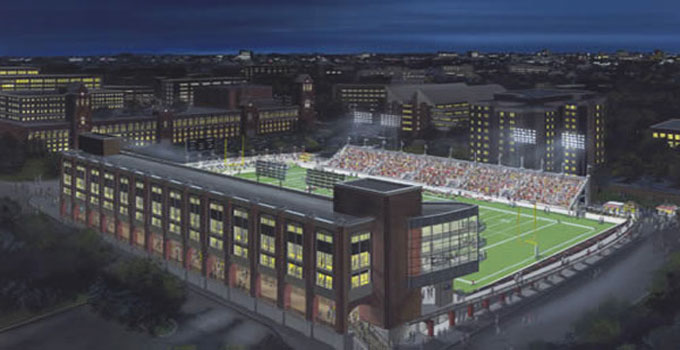

What was fundraised (2005):
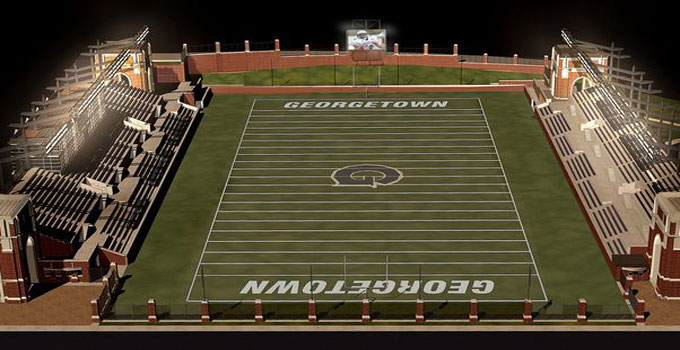

What was deemed affordable (2007):
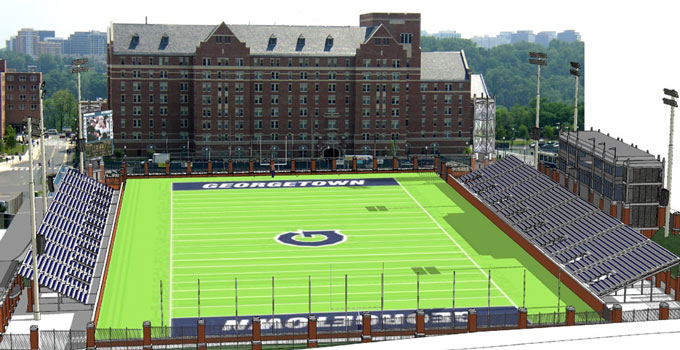

And what it is today:
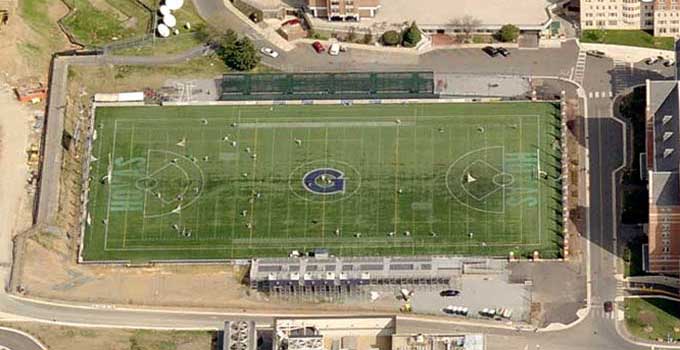

"Little more than an unremarkable football field just six months ago, the developing Multi-Sport Facility has emerged into what some officials are calling the most important addition to Georgetown’s campus in recent decades.
The facility will continue to hold events for the football team and the men’s and women’s lacrosse and soccer teams. With a planned seating capacity of 4,500, Bob Benson, head coach for the Georgetown football team, promises that it will be the new athletic hub of the university upon completion.
“[The MSF] will probably be the most important addition to this campus in the last 50 to 100 years,” Benson said...
Jeanne Fisher-Thompson, interim director of athletic development, called it “a meeting place for students, which is not just for athletics.” Fisher-Thompson said that the field would play host to concerts and other events, as well as provide much-needed “green space” for students.
The MSF has been under construction since April of this year. The current structure only reflects the completion of the first of two main construction phases that have been planned...According to [Vice President of Facilities and Student Housing Karen] Frank, the timing on the construction of phase two is dependent on the simultaneous progression of three elements – design, zoning and fundraising. “When those three pieces converge, then we’ll build,” she said.
The more in-depth designs for the second phase of the project are nearly complete. “We’re going along, we’re trying to do the detailed design so we can get better [cost] numbers,” Frank said...
Fisher-Thompson described fundraising for phase two as “on track.”
-The HOYA, Oct. 7, 2005
Georgetown has “conversations” on the MSF. It maintains “dialogue”. It seeks “opportunities” to see progress. These are words better suited to a discussion on ethics, not construction projects, and certainly not projects where money was raised and accepted. And according to that story cited above, $12.7 million is not an insignificant number....
Because a the bottom of all this, this project is all about commitment, one which unfortunately speaks loud and clear to recruits, to parents, and to fellow coaches. It’s hurt football recruiting, even if people won’t say it, and it has hurt lacrosse recruiting, even if people won’t say that, either. How can Georgetown be committed to sports like football if it doesn’t even finish what it started?
The University doesn’t need a replica of AT&T Stadium for a facility, even if Jerry Jones himself is the parent of an football alum. It doesn’t need another Byrd Stadium, named after a former Georgetown quarterback, no less. [Dan] Porterfield’s goals in that 2009 letter were simple and direct: “To improve our teams' game-day experience, to make the venue more fan-friendly, and to construct an aesthetically pleasing facility.”
This project needs ownership and a frank discussion with its donors about what it is prepared to do…and what it expects its donors to do in return. And those in McDonough Gym that are used to my squawking about this subject understand it’s not personal, that despite talk that things are getting closer, some of us have heard that offer for too many years now.
In the meantime, day 3,000 will be day 3,001 before we know it.
-Third Rail Blog, Dec. 14, 2013
